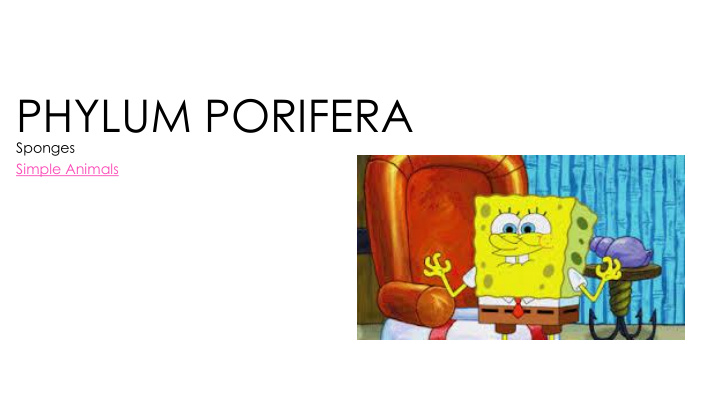



PHYLUM PORIFERA Sponges Simple Animals
SPONGES • Simplest and most unusual animals • Most ancient animals • Around 540 million years old • Aquatic animals • Ocean and fresh water • Variety of colours, shapes and sizes • Porifera means “pore bearer” • Sessile
WHY IS A SPONGE AN ANIMAL? • Heterotrophic • Multicellular • No cell wall • A few specialized cells
“PORE BEARERS” • Sponges have tiny openings/pores all over their bodies
BODY PLAN • Asymmetrical • Only two layers • Endoderm and ectoderm • No body cavity • Large cylindrical water pump • Body forms around a wall around a large central cavity in which water is continually circulated • Movement of water through a sponge provides a simple mechanism for feeding, respiration, circulation and excretion
STRUCTURE AND FUNCTION • Water enters through pores located in the body wall • Leaves through the osculum • a large hole at the top of the sponge. • Function • Expels water and wastes
• Choanocytes • Specialized cells with flagella • Function: • use flagella to move a steady current of water through the sponge.
SKELETON • Harder sponges • Made of spiny spicules • spicule is a spike-shaped structure made of calcium carbonate or silica. • Spicules are made by archaeocytes • specialized cells that move around within the walls of the sponge
• Softer sponges • Internal skeleton made of spongin • Network of flexible protein fibers • These softer sponges are harvested and used as natural bath sponges
FEEDING • Feeding • No mouth or gut • Sponges are filter feeders. • Intracellular digestion • As water moves through the sponge, food particles are trapped and engulfed by choanocytes Particles are then passed on • to archaeocytes (amoebocytes) • Rely on movement of water Complete the digestive • process and transport digested food throughout the sponge
RESPIRATION, CIRCULATION & EXCRETION • As water moves through the body oxygen from the water diffuses into the surrounding cells • Carbon dioxide and wastes( ammonia) diffuse into the water and are carried away
RESPONSE • Do not have a nervous system • Produce toxins to prevent potential predators
REPRODUCTION • Reproduce both sexually and asexually • A single sponge can produce both sperm and egg • Eggs are fertilized inside a sponges body • Internal fertilization • Sperm are released from one sponge • Carried by water currents to pores of another sponge • Archaeocytes carry sperm to egg • Zygote forms, develops into larva • Larva is an immature stage of an organism that looks different from its adult form • Larva are motile, carried by currents to a new location
ASEXUAL REPRODUCTION • Budding • Part of a sponge breaks off of parent • Settles to the sea floor and grows into a new sponge • Gemmule production • Occurs when harsh environmental conditions exist • Gemmules are groups of archeocytes surrounded by a tough layer of spicules • When conditions become favourable • Gemmule grows into new sponge
ECOLOGY OF SPONGES • Sponges are important in aquatic ecology. • They provide habitats for marine animals • snails, sea stars, and shrimp • Symbiotic relationships • Commensalism • Habitats • Mutualism • Partnerships with photosynthetic bacteria, algae, protists Photosynthetic organisms provide • food/oxygen Sponges proved protected area •
• https://www.youtube.com/watch?v=m8a0oNsDEx8
Recommend
More recommend